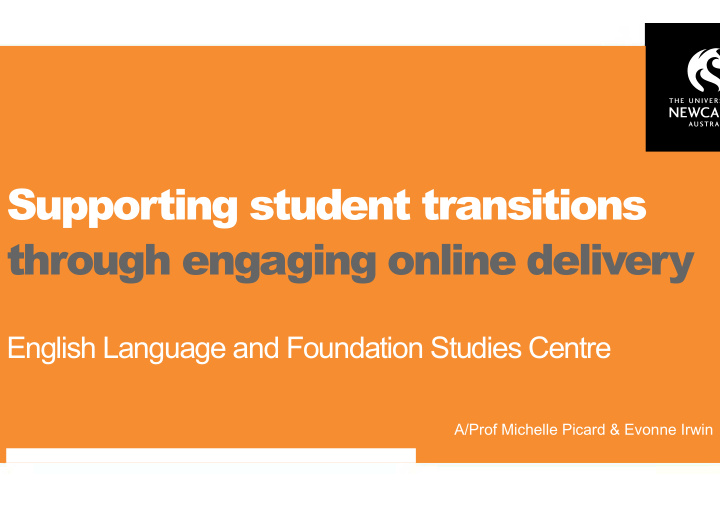



Supporting student transitions through engaging online delivery English Language and Foundation Studies Centre A/Prof Michelle Picard & Evonne Irwin
Opportunity through Online Learning D r C a t h y S t o n e ( 2 0 1 7 ) Students from low socioeconomic backgrounds (low SES), students with disability, regional and remote students, Indigenous students, and students who are first in their families to enter university, are represented particularly strongly in online undergraduate programs. However, both retention and completion rates for online, distance students are considerably lower than amongst those enrolled as on-campus students. Combined wisdom of practitioners in online learning to inform the development of National Guidelines to Improve Student Outcomes in Online Learning.
Dr Cathy Stone 1. Know who the students are 6. Engage and support through content and 2. Develop, implement and regularly review delivery institution-wide quality standards for delivery 7. Build collaboration across campus to of online education offer holistic, integrated and embedded 3. Intervene early to address student student support expectations, build skills and 8. Contact and communicate throughout the engagement student journey 4. Explicitly value and support the vital role 9. Use learning analytics to target and of ‘teacher presence’ personalise student interventions 5. Design for online 10.Invest in online education to ensure access and opportunity
Open Foundation Online • From paper-based Distance program to fully online 2012 • Currently 8 discipline-based courses which run part-time across two semesters • Law • Nursing & Midwifery • Linguistics • Business • Australian History • Chem/Life Sciences • Introductory Mathematics/Extension Maths • Foundations of Education (in development: release 2019) • Environmental Science (in development: release 2020)
1. Know who the students are
4. Explicitly value and support the vital role of ‘teacher presence 6. Engage and support through content and delivery 8. Contact and communicate throughout the student journey
3. Intervene early to address student expectations, build skills and engagement 6. Engage and support through content and delivery
5. Design for online • Navigation – consistent and intuitive • existing website conventions • logical menu sequence (not simply alphabetical) • limit number of menu items • predictable
5. Design for online Language/instructions – simple, check assumptions Sequencing learning Consider learning preferences and use appropriate pedagogies/ methods Multiple opportunities for feedback and connection Accessibility
Build collaboration across campus to offer holistic, integrated nd embedded student support Contact and communicate throughout the student journey Support • Explicit • Timely • Targeted
Advice for online educators 9. Use learning analytics to target and personalise student interventions
Resources Dinmore, S. & Stokes, J. (2015). Creating inclusive university curriculum: Implementing universal design for learning in an enabling program. Widening Participation and Lifelong Learning, 17 (4), pp 4-19. Stone, C. (2017). Opportunity through online learning: Improving student access, participation and success in higher education. NCSEHE 2016 Equitiy Fellowship Final Report. https://www.ncsehe.edu.au/publications/opportunity-online-learning-improving-student- access-participation-success-higher-education/ Mishra & Koehler (2006). TPACK: Technological Pedagogical Content Knowledge conceptual framework. http://tpack.org/ Salmon, G. various works. Carpe Diem and e-tivities.
thank you
Recommend
More recommend